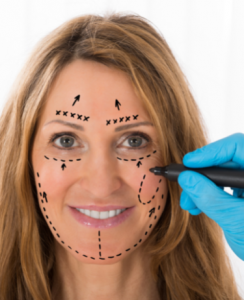The facelift is one of the safest, fastest, and most effective elective medical procedures to erase the signs of aging from the face. It’s suitable for most adults who want to get rid of wrinkles, laugh and frown lines, creases, sagging, and eliminate volume loss to rejuvenate their facial features.
As popular and common as the procedure is, sometimes unexpected issues leave behind undesirable effects on the face. According to the American Academy of Facial Plastic and Reconstructive Surgery, over 1.4 million surgical and nonsurgical cosmetic procedures are performed in the United States annually. While every effort is made to perform each procedure safely to help patients achieve their facial rejuvenation goals, facelift revisions are common and necessary for some.
What Is a Facelift Revision?
Facelift revisions are often sought out by patients who require additional work on their faces to maintain a fresh and youthful appearance. There are different types of facelift procedures, and each uses certain techniques to lift and rejuvenate the facial muscles and skin.
Ideally, patients are advised to wait six months or longer before considering facelift revisions for optimal healing and recovery. The skin on the face is sensitive, and facelift results take time to appear. Having modifications prematurely can cause more harm than good and make it difficult for the surgeon to correct any issues that crop up afterward. Undergoing secondary rhytidectomy too soon can negatively impact the patient’s appearance and treatment goals.
 Common Reasons for Facelift Revisions
Common Reasons for Facelift Revisions
Facelift revision is also referred to as revision rhytidectomy and is available for patients who are unhappy with the results of previous procedures. Revisions are done to correct the ongoing effects of aging in past facelift patients. When performed by a facelift expert, results can last for years. However, there are factors that can cause results to degrade faster than normal or expected. Revisions offer more than just cosmetic benefits for patients. Facelift revisions also improve patient self-esteem, confidence, and overall mental health.
Patients across the country come to California to have facelift revisions at the Matt Hershcovitch, M.D., Facial Plastic Surgery clinic to correct the following concerns:
Unrealistic Expectations: A consultation with a board-certified cosmetic surgeon is necessary before patients can undergo a facelift. This meeting is necessary so patients can meet the surgeon to review and verify their credentials, discuss their facial concerns and learn treatment recommendations that are best suited for their goals and situations.
The consultation is also when the surgeon informs patients of what they can expect to achieve from the procedure, so they have clear and realistic expectations about the procedure. Some patients, despite being informed, become unsatisfied with results or expect more than they should from previous facelifts.
Scars and Skin Discoloration: Surgical facelifts involve cutting, draping, and manipulating the skin, muscles, and underlying structures to tighten and transform one’s facial appearance. The procedure does cause temporary swelling, discoloration, irritation, and bruising.
Scar tissue is also normal, but unlike bruising, swelling, etc., tends to become more noticeable and, in some cases, difficult to mask as time goes on. These effects are more noticeable in patients whose facial skin or muscles are pulled and draped too tightly from previous surgeries.
Malar Bags and Crescents Under the Eyes: Sometimes, previous facelifts fail to adequately tighten the muscles or remove too much fatty tissue underneath the eye and cheek areas. When combined with the continuous aging process, the muscles and the skin in these areas start to droop and sag, causing the bony structures of the eye sockets to become more prominent. Many people get facelift revisions to fix malar crescent bags and eliminate the sunken and hollow-eyed appearance.
Results Fade Prematurely: It is quite normal for the face to undergo many changes for several months after a facelift as the skin and muscles heal and adjust. While highly effective at correcting aging issues on the face, it takes time for results to develop, and those that do are not always satisfactory to patients. Some settling of the facial features is to be expected after a facelift.
Unexpected changes and issues can occur due to external and patient-specific factors that cause facelift results to not age well and deteriorate faster than expected.
Cobra Neck/Sagging in the Neck: The aging process has a gravitational effect on the skin, fat, and muscles of the body, in particular, the face and neck. As time progresses, previous modifications (the removal of fat deposits and inadequate tightening practices) made to the neck and jowl areas can cause the skin and underlying tissues to hang and pool unnaturally to one side or in the center.
Taunt Skin or Bony Appearance: Facelifts involve using various techniques to tighten, lift and smooth the skin on the face. When too much fat or skin is removed, or the skin and underlying muscles are pulled too tightly, the result is a gaunt, fake appearance. The facial skin may also feel too tight and cause discomfort, pain, difficulty, and cosmetic concerns when moving.
Too much tension and improper lifting and draping practices are also common in facelift revision patients with concerns about pixie or pointy and elongated ears and who don’t want to appear as if they had any work done. Facelift revisions are popular among people who want to make previous results look more organically or naturally attractive.
How Many Times Can I Get a Facelift Revision?
Revision?
Aging never stops! It’s standard practice for some to use cosmetics, beauty products, and even nutritional supplements to slow the aging process and mask its effects. However, none of those measures can provide dramatic results like a facelift. Unlike conventional methods, facelifts enable patients to target cosmetic issues to boost their self-esteem and confidence in their appearances.
It’s only natural for previous facelift patients to be concerned about preserving their facial rejuvenation results, especially if they experience any of the concerns above. There’s no definitive answer on how many facelift revisions a person can have.
Facelift revision recommendations depend on the patient’s facial anatomy and skin tissues. Many patients have multiple facelifts throughout their lives at set intervals to help them age more gracefully.
When performed by a highly experienced and successful double board-certified facial plastic surgeon specializing in facelifts like Dr. Matt Hershcovitch, M.D., there’s no such thing as a bad facelift. Because multiple facelift revision surgeries make the skin thinner and more fragile, a consultation is necessary to ensure optimal treatment recommendations.
Contact Matt Hershcovitch, M.D., Facial Plastic Surgery, at (818) 206-2539.

 Common Reasons for Facelift Revisions
Common Reasons for Facelift Revisions Revision?
Revision?